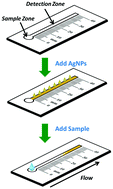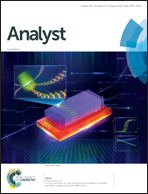A distance-based paper sensor for the determination of chloride ions using silver nanoparticles†
Abstract
We report for the first time the development of a distance-based paper sensor for a simple, inexpensive, instrument-free, and portable determination of chloride ions. Our analysis reaction is based on the oxidative etching of silver nanoparticles (AgNPs) to form AgCl in the presence of Cl− and H2O2. H2O2 reacts with AgNPs in the channel of the paper device and Cl− in the sample forming a white precipitate (AgCl) where the white color band length is proportional to the Cl− concentration. Quantification of Cl− is achieved by measuring the length of the white color band using a ruler printed on the side of the channel. Under optimal conditions, the distance-based paper sensor was characterized by a working range of 25–1000 mg L−1 (R2 = 0.9954) and the naked eye detection limit (LOD) was 2 mg L−1 (0.08 μg). Our sensor was found to be reproducible with a relative standard deviation of less than 4.51% (n = 10). The levels of Cl− in real water samples measured using our proposed device were within the error of the values measured using traditional tests but without the need for any external instrumentation. Therefore, our proposed method presents acceptable accuracy, precision, and high selectivity for point of need monitoring of Cl− in real water samples.



 Please wait while we load your content...
Please wait while we load your content...